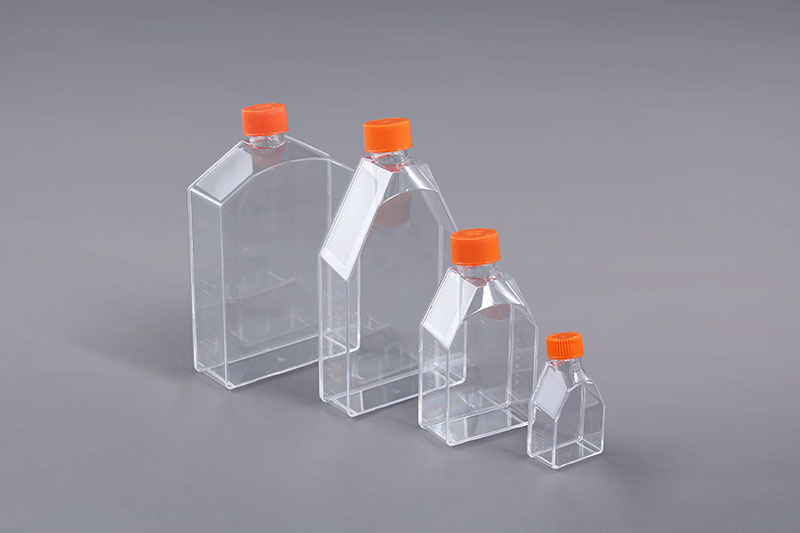The cell culture flask is a kind of cell consumable that is used in life research and practice. It is mostly used for the cultivation of adherent cells. During use, the correct operation method is the prerequisite to ensure the smooth progress of the experiment. Pay attention to the following when using this consumable What time is it:
1. About the lid: Do not tighten the lid of the disposable cell culture flask too tightly to ensure gas exchange. HEPES is a non-ionic buffer with good buffering capacity in the pH range of 7.2-7.4, but it is very expensive and may be toxic to some cells at high concentrations. HEPES buffer can be used with low-level sodium carbonate (0.34g/L) to offset the increase in osmotic pressure caused by the addition of HEPES. Under this culture condition, the lid of the disposable cell culture flask should be tightened to prevent the small amount of carbonate in the culture solution from dispersing into the air. Most culture fluids contain phenol red as a pH indicator, acidic culture fluids are orange-yellow, and alkaline culture fluids are dark red.
2. Reduce "growth cavity": Most users use not pre-coated disposable cell culture flasks, but ordinary disposable cell culture flasks. The surface environment is not conducive to the mesenchymal stem cell paste in the serum-free culture environment. wall. Place it at 37°C for 5-10 minutes to better combine the adhesion-promoting substances in the culture medium with the bottom of the disposable cell culture flask, which enhances the adhesion ability of mesenchymal stem cells and reduces the probability of "growth holes".
3. Cell digestion: Put the bottle upright and suck off the culture medium. If there are more exfoliated cells in the culture medium, it means that the cells are now easy to fall off. Just add 1ml of PBS+EDTA (0.02%) and shake the culture bottle back and forth slightly until Cells fall off completely, add 10ml MEM, mix well, do not pipette, divide into 2 bottles, if the cells fall off without overgrowth, just add 5ml MEM, no separate packing. If the cells in the bottle adhere firmly, the medium supernatant has no cell shedding debris, and the cells are over 80% overgrown, aspirate the medium, add 5ml of PBS+EDTA (0.02%), quickly shake it slightly, and culture it upright Aspirate the bottle, add 1ml of 0.05% pancreatin, digest at 37°C for no more than 3 minutes, and the cells will be completely digested and peeled off. Take out and add 10ml of culture medium to gently pipet and mix, and divide into 2 bottles.
Cells are very sensitive to the growth environment. As a more commonly used consumable, cell culture flasks should be operated carefully and strictly follow the prescribed procedures to avoid improper operations that affect cell growth.
The FAI climbed 5.9 percent year-on-year in the first 11 months of 2018, quickening from the 5.7-percent growth in Jan-Oct, the National Bureau of Statistics (NBS) said Friday in an online statement.
The key indicator of investment, dubbed a major growth driver, hit the bottom in August and has since started to rebound steadily.
In the face of emerging economic challenges home and abroad, China has stepped up efforts to stabilize investment, in particular rolling out measures to motivate private investors and channel funds into infrastructure.
Friday's data showed private investment, accounting for more than 60 percent of the total FAI, expanded by a brisk 8.7 percent.
NBS spokesperson Mao Shengyong said funds into weak economic links registered rapid increases as investment in environmental protection and agriculture jumped 42 percent and 12.5 percent respectively, much faster than the average.
In breakdown, investment in high-tech and equipment manufacturing remained vigorous with 16.1-percent and 11.6-percent increases respectively in the first 11 months. Infrastructure investment gained 3.7 percent, staying flat. Investment in property development rose 9.7 percent, also unchanged.
 English
English



















































